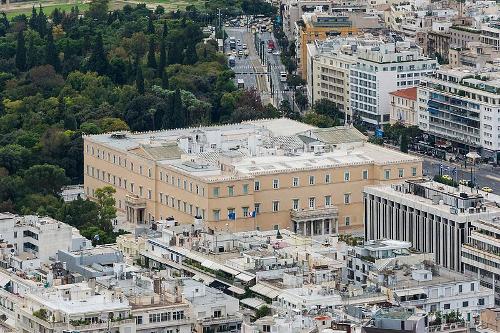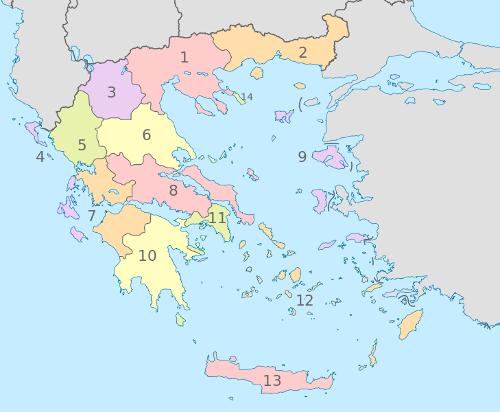PELOPONNESE
Society

Society

Popular destinations GREECE
| Aegina | Alonissos | Andros |
| Chios | Corfu | Crete |
| Hydra | Kalymnos | Karpathos |
| Kefalonia | Kos | Lefkas |
| Lesbos | Mykonos | Naxos |
| Paros | Patmos | Peloponnese |
| Poros | Rhodes | Samos |
| Santorini | Skiathos | Skopelos |
| Spetses | Thasos | Zakynthos |
Society
State structure
 Greece VouliPhoto: Jebulon in the public domain
Greece VouliPhoto: Jebulon in the public domain
The constitution dates from 1975, after which important amendments were made in 1986. Legislative power rests with the unicameral parliament (the "Vouli"), whose 300 members are elected once every four years under an "enhanced right of proportional election". The system favors the strongest party in order to achieve a majority sufficient for government, which, however, encourages a two-party system.
The head of state is the president, who is elected by parliament (a two-thirds majority is required) for a term of five years and is eligible for re-election once. The president appoints and dismisses the prime minister. He may also dissolve parliament and in a state of emergency he can issue laws by decree. His function is largely ceremonial, as head of state he has no executive power. This power rests with the Council of Ministers, which is accountable to parliament for this. There is universal suffrage for all Greeks from the age of 18.
After the military dictatorship, a popular vote on the return of the monarchy to the disadvantage of ex-king Constantine was unfavorable. For the current political situation see chapter history.
Administrative division
 Greece administrative divisionPhoto: TUBS CC 3.0 Unported no changes made
Greece administrative divisionPhoto: TUBS CC 3.0 Unported no changes made
Greece is divided into 13 administrative divisions, the so-called "Peripheries" (districts). These "Peripheries" are subdivided into prefectures. A prefecture is called a "Nomos", with a "nomoi" at its head. In total there are 51 prefectures. In addition, Greece has one autonomous area under its own administration, namely Agion Oros (Mount Athos) in Chalkidiki (Northern Greece). Greater Athens has a separate status. The other provinces are: Central Greece, Peloponnese, Ionian Islands, Epiros, Thessaly, Macedonia, Thrace, Aegean Islands and Crete.
A place of residence is then called either "Dimos" (municipality, city) or "Kinotita" (community, village). In total there are 900 municipalities and 133 communities.
The administrative region of Peloponnese, with its capital at Tripolis, consists of the following five regional units:
-Argolis, capital city Nauplion
-Arcadia, capital city Tripolis
-Corinthia: capital city Corinth
-Laconia: capital city Sparta
-Messenia: capital city Kalamata
The Peloponnese is not a homogeneous region: Elia and Achaea in the northwest, including the important port of Patras, belong to the administrative region of Western Greece; a small area in the eastern Peloponnese belongs to the administrative region of Attica.
Since the 2011 administrative reorganisation, the Peloponnese administrative region consists of the following 26 merged municipalities or 'dimos':
| Anatoliki Mani | Korinthe | Pylos-Nestoras |
| Argos-Mykines | Loutraki-Agioi Theodoroi | Sparta |
| Dytiki Mani | Megalopolis | Sikyona |
| Elafonisos | Messene | Trifylia |
| Epidauros | Monemvassia | Tripolis |
| Ermionida | Nauplion | Velo-Vocha |
| Evrotas | Nemea | Voreia Kynouria |
| Gortynia | Notia Kynouria | Xylokastro-Evrostina |
| Kalamata | Oichalia |
Sparta and the Spartans, a soldier nation
There are only a few nations that can be characterised as a soldier people, besides Sparta one could also include the Zulus under Shaka. The most famous king of the Spartans was Leonidas.
Every male Spartan was obliged to become a soldier, from his 20th until his 60th year. Work in the fields was done by 'helots', a kind of slaves who were the original inhabitants of the area around Sparta. From the age of seven, a child was taken away from its mother, put into barracks and started the hard, tough training to become a soldier. At the age of 18, the boys were put into a kind of reserve army and at the age of 20, the real work began. People continued to live in the soldiers' barracks, even if they were married.
Olympic Games in Antiquity
Olympia is the most famous site in the Peloponnese, and the original Olympic Games were held here uninterruptedly for more than 1000 years. According to the ancient Greeks, the very first Olympic Games in which the names of the victors were recorded were held in 776 BC, although it is almost certain that athletic events were held before that time as well. Therefore, 776 BC is the beginning of Greek timekeeping.
Initially, the Games were a religious festival with a running distance as a 'side issue'. Over the years, the athletics in particular grew into what people came to see from far and wide, including outside Greece. At its peak, the Games attracted thousands of spectators from all over the Mediterranean. In those days, it was not only sports that were played, but poets and musicians could also show off their talents. The Olympic Games were organised every four years and judged by the people of the small city-state of Elis, which also managed to enforce a period of truce, even the warlike Sparta.
As for the sporting part, initially the running numbers were by far the most important. The various numbers were run in the stadium, which could hold 40,000-50,000 spectators, by naked men (women did not participate), usually the length of the stadium, 600 Attic feet (192.27 metres). The longest running number was 6x up and down. Also important was the pentathlon, from which the all-round athlete emerged, as the components were wrestling, running, discus throwing, javelin throwing and long jump (probably from standing and carrying weights). Later, boxing, chariot racing and 'pankration', a barely regulated mix of boxing and wrestling, were added. The winners were rewarded with a palm branch, a head wreath of olive leaves and eternal glory, especially in their home town. Women and slaves were not allowed into the stadium; they could watch from Cronos Hill.
Christianity finally put an end to the ancient Olympic Games. In 393 AD, Theodosius I the Great declared that all pagan festivals, including the Olympic Games, were forbidden. In 426 Theodosius II ordered the destruction of all pagan temples. Recent research has shown that the buildings were further destroyed by an earthquake and subsequent tsunami in 551. The ruins were covered with a metre-thick layer of mud; it was not until 1766 that the Englishman Richard Chandler rediscovered the site and carefully began excavations. It was not until the 1970s, however, that excavation work intensified, especially by German archaeologists such as Ernst Curtius, Carl Ritter and Alexander von Humboldt, who were supported by the Prussian King Friedrich Wilhelm IV.
Besides the Olympic Games there were other so-called Panhellenic Games, including the Nemeic Games, the Pythian Games and the Isthmian Games.
Corinth Canal
The idea of digging a canal through the Corinthian isthmus to connect the Ionian Sea and the Aegean Sea has existed since the reign of Periander, a tyrant of Old Corinth at the end of the 7th century B.C. The plan, however, was far too ambitious for Periander, and instead a 'diolkos' was built, a kind of stone slipway that allowed (small) ships to be 'rolled' from one side to the other. This method was used until the 13th century AD.
In the intervening years, many leaders, including Alexander the Great and the Roman Emperor Caligula, played with the canal idea, but in the end it was only Emperor Nero who actually started digging in 67 AD, at least, some 6000 Jewish prisoners did the work before him. However, invasions by the Gauls soon put an end to the work, and it was not until the end of the 19th century (1883-1893) that the canal was actually dug by a French construction company. Today, modern ships hardly ever use the canal, which is too narrow for its time.
Sources
Wikipedia
CIA - World Factbook
BBC - Country Profiles
Last updated June 2025Copyright: Team The World of Info